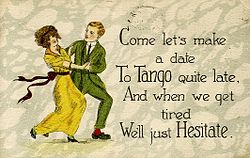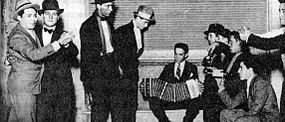History of the tango

Tango, a distinctive
Etymology
There are numbers of theories about the origin of the word "tango". One of the more popular in recent years has been that it came from the
Origin
The Tango derives from the Cuban habanera, the Argentine
Even though the present forms developed in Argentina and Uruguay from the mid 19th century,[8] there are earlier written records of Tango dances in Cuba and Spain,[9][10] while there is a flamenco Tangos dance that may share a common ancestor in a minuet-style European dance.[5] All sources stress the influence of the African communities and their rhythms, while the instruments and techniques brought in by European immigrants played a major role in its final definition, relating it to the salon music styles to which Tango would contribute back at a later stage, when it became fashionable in early 20th century Paris.
Argentina’s Immigration Policy in the 19th Century
In Argentina, the word Tango seems to have first been used in the 1890s. In 1902 the
In the late 19th and early 20th centuries, Argentina experienced a significant wave of immigration that transformed its demographic composition. The immigration policy at the time was shaped by the Argentine elites’ desire to promote economic growth, their need to populate its vast territories, their aspiration to become a modern and civilized nation, as well as their racial and nationalist ideologies that sought to establish a homogenous and European-based population.[12] To attract immigrants, the Argentine government implemented various measures, such as offering free land, providing financial incentives, and establishing immigration agencies in Europe.[12]
However, this influx of diverse immigrants also led to social tensions and conflicts which engendered nationalist movements that sought to promote a “pure” Argentine identity aimed to exclude the more inferior immigrants.[12] Under the Argentine government's efforts to Europeanize and modernize the country, those who did not fit the “pure” and civilized image of the Argentine identity were excluded from urban centers like Buenos Aires and gradually pushed to the arrabal, the suburbs between urban and rural areas.[13] It was in these arrabales that different marginalized groups converged while expressing themselves in dances.[14] They frequently met in “tangos” where whites and people of color played music and danced together.[15] Afro-Argentines and the other working-class populations were especially crucial in shaping the emergence of tango by combining the different influences, including the milonga, the condombe, payada.[14][16]
Becoming A National Symbol
At the beginning of its history, tango was looked down upon by the Argentine elites for a number of reasons. First of all, tango's associations with marginalized groups, especially the immigrants and people of African descent, who were considered lower-class and uncivilized, made tango the dance form seem vulgar and immoral, thus unsuitable for respectable society.[16] Additionally, tango was also closely associated with brothels and bars of Buenos Aires, which the elites also considered disreputable.[16] Many of the early tango lyrics and moves were considered to be too sexually suggestive, exacerbating the elites’ disdain for the dance.[16] These characteristics of tango significantly deviated from the Argentine elites’ nationalist agenda to promote an image of Argentine identity that emphasized European sophistication and refinement.[16] Consequently, the elites saw tango as a threat to their cultural hegemony.
During the period 1903–1910 over a third of the 1,000

By 1912, dancers and musicians from
As the dance form became wildly popular with upper and middle classes around the world, Argentine high society adopted the previously low-class dance form as their own. However, the Argentine high society did a few significant modifications to the dance form before elevating its social status. One such change was the adoption of a more respectful style of dance by encouraging the dancers to adopt a more upright posture and to eliminate the more sexually provocative movements.
In 1917, folk singer Carlos Gardel recorded his first tango song Mi Noche Triste, forever associating tango with the feeling of tragic love as revealed in the lyric. During the first decade of the 20th century, some songs under the name of tango were recorded, but these recordings did not achieve great popularity. However, in 1921, 'El Sonido de la Milonga' helped bring about the rise of tango, and introduced it properly as a form to the people.
Classically trained musicians weren't associated with tango music until
In Argentina, the onset in 1929 of the
The dance lived on in smaller venues until its revival in the 1980s following the opening in Paris of the show
See also
- Chamarrita
- Finnish tango
- Lunfardo
- Maxixe (dance) (or Brazilian tango)
- Tango (ballroom)
- Queer Tango
- Argentine tango
- Uruguayan tango
Further reading
- Collier, Simon (1995). Tango! : the dance, the song, the story. New York, NY: Thames and Hudson. ISBN 0500016712.
References
- ^ Termine, Laura (30 September 2009). "Argentina, Uruguay bury hatchet to snatch tango honor". Buenos Aires. Retrieved 2 April 2010.
- ISBN 0-8420-2485-9
- ^ Online Etymology Dictionary
- ISBN 0-8223-2914-X.
tango etymology.
- ^ a b c Denniston, Christine. Couple Dancing and the Beginning of Tango 2003
- ISBN 978-0-19-992923-8.
- ^ JSTOR 4289184.
- ^ Several paintings by the Uruguayan artist Pedro Figari (1861-1938) dating from the 19th Century depict tango being danced there.
- ^ Esteban Pichardo, Diccionario Provincial de Voces Cubanas (Matanzas, Imprenta de la Real Marina, 1836, Pg. 242)
- ^ José Luis Ortiz Nuevo El origen del tango americano Madrid and La Habana 1849
- ^ a b c Reflections about the origins of tango, Ricardo García Blaya
- ^ ISBN 978-0-8130-6000-2, retrieved 7 April 2023
- ^ Tabares, Lorena (1 January 2014). "The Argentine Tango As A Discursive Instrument And Agent Of Social Empowerment: Buenos Aires, 1880-1955". Open Access Theses & Dissertations.
- ^ JSTOR 27923034– via JSTOR.
- ^ Gobello, José (1999). Breve Historia Crítica Del Tango. Buenos Aires: Corregidor.
- ^ ISBN 9780429497001.
- ^ )
- ^ a b Denniston, Christine. A Brief Introduction to the History of Tango Music
- ^ Denniston, Christine. "The History of Tango Dance". Self. Retrieved 7 May 2012.
- ^ ""Antes éramos todos cantores de esquina y jugadores de potrero"" (in Spanish). Nos Digital. 24 June 2013. Archived from the original on 30 September 2013.
